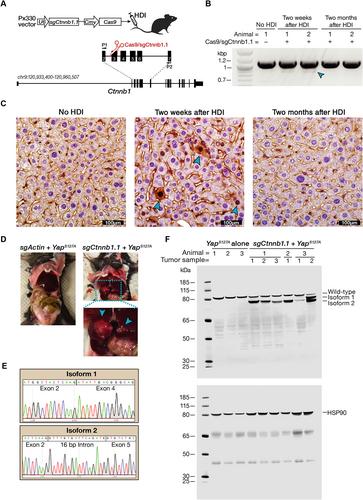CRISPR-induced exon skipping of β-catenin reveals tumorigenic mutants driving distinct subtypes of liver cancer
Haiwei Mou, Onur Eskiocak, Kadir A. Özler, Megan Gorman, Junjiayu Yue, Ying Jin, Zhikai Wang, Ya Gao, Tobias Janowitz, Hannah V. Meyer, Tianxiong Yu, John E Wilkinson, Alper Kucukural, Deniz M. Ozata, Semir Beyaz
下载PDF
{"title":"CRISPR-induced exon skipping of β-catenin reveals tumorigenic mutants driving distinct subtypes of liver cancer","authors":"Haiwei Mou, Onur Eskiocak, Kadir A. Özler, Megan Gorman, Junjiayu Yue, Ying Jin, Zhikai Wang, Ya Gao, Tobias Janowitz, Hannah V. Meyer, Tianxiong Yu, John E Wilkinson, Alper Kucukural, Deniz M. Ozata, Semir Beyaz","doi":"10.1002/path.6054","DOIUrl":null,"url":null,"abstract":"<p>CRISPR/Cas9-driven cancer modeling studies are based on the disruption of tumor suppressor genes by small insertions or deletions (indels) that lead to frame-shift mutations. In addition, CRISPR/Cas9 is widely used to define the significance of cancer oncogenes and genetic dependencies in loss-of-function studies. However, how CRISPR/Cas9 influences gain-of-function oncogenic mutations is elusive. Here, we demonstrate that single guide RNA targeting exon 3 of <i>Ctnnb1</i> (encoding β-catenin) results in exon skipping and generates gain-of-function isoforms <i>in vivo</i>. CRISPR/Cas9-mediated exon skipping of <i>Ctnnb1</i> induces liver tumor formation in synergy with YAP<sup>S127A</sup> in mice. We define two distinct exon skipping-induced tumor subtypes with different histological and transcriptional features. Notably, ectopic expression of two exon-skipped β-catenin transcript isoforms together with YAP<sup>S127A</sup> phenocopies the two distinct subtypes of liver cancer. Moreover, we identify similar <i>CTNNB1</i> exon-skipping events in patients with hepatocellular carcinoma. Collectively, our findings advance our understanding of β-catenin-related tumorigenesis and reveal that CRISPR/Cas9 can be repurposed, <i>in vivo</i>, to study gain-of-function mutations of oncogenes in cancer. © 2023 The Authors. <i>The Journal of Pathology</i> published by John Wiley & Sons Ltd on behalf of The Pathological Society of Great Britain and Ireland.</p>","PeriodicalId":232,"journal":{"name":"The Journal of Pathology","volume":"259 4","pages":"415-427"},"PeriodicalIF":5.6000,"publicationDate":"2023-01-15","publicationTypes":"Journal Article","fieldsOfStudy":null,"isOpenAccess":false,"openAccessPdf":"https://pathsocjournals.onlinelibrary.wiley.com/doi/epdf/10.1002/path.6054","citationCount":"1","resultStr":null,"platform":"Semanticscholar","paperid":null,"PeriodicalName":"The Journal of Pathology","FirstCategoryId":"3","ListUrlMain":"https://onlinelibrary.wiley.com/doi/10.1002/path.6054","RegionNum":2,"RegionCategory":"医学","ArticlePicture":[],"TitleCN":null,"AbstractTextCN":null,"PMCID":null,"EPubDate":"","PubModel":"","JCR":"Q1","JCRName":"ONCOLOGY","Score":null,"Total":0}
引用次数: 1
引用
批量引用
Abstract
CRISPR/Cas9-driven cancer modeling studies are based on the disruption of tumor suppressor genes by small insertions or deletions (indels) that lead to frame-shift mutations. In addition, CRISPR/Cas9 is widely used to define the significance of cancer oncogenes and genetic dependencies in loss-of-function studies. However, how CRISPR/Cas9 influences gain-of-function oncogenic mutations is elusive. Here, we demonstrate that single guide RNA targeting exon 3 of Ctnnb1 (encoding β-catenin) results in exon skipping and generates gain-of-function isoforms in vivo . CRISPR/Cas9-mediated exon skipping of Ctnnb1 induces liver tumor formation in synergy with YAPS127A in mice. We define two distinct exon skipping-induced tumor subtypes with different histological and transcriptional features. Notably, ectopic expression of two exon-skipped β-catenin transcript isoforms together with YAPS127A phenocopies the two distinct subtypes of liver cancer. Moreover, we identify similar CTNNB1 exon-skipping events in patients with hepatocellular carcinoma. Collectively, our findings advance our understanding of β-catenin-related tumorigenesis and reveal that CRISPR/Cas9 can be repurposed, in vivo , to study gain-of-function mutations of oncogenes in cancer. © 2023 The Authors. The Journal of Pathology published by John Wiley & Sons Ltd on behalf of The Pathological Society of Great Britain and Ireland.
crispr诱导的β-catenin外显子跳变揭示了驱动不同亚型肝癌的致瘤突变
CRISPR/ cas9驱动的癌症建模研究是基于肿瘤抑制基因被小的插入或缺失(indel)破坏,从而导致帧移突变。此外,在功能丧失研究中,CRISPR/Cas9被广泛用于定义癌症致癌基因的意义和遗传依赖性。然而,CRISPR/Cas9如何影响功能获得性致癌突变是难以捉摸的。在这里,我们证明了靶向Ctnnb1(编码β-catenin)的外显子3的单个引导RNA导致外显子跳跃并在体内产生功能获得异构体。CRISPR/ cas9介导的Ctnnb1外显子跳变与YAPS127A协同作用诱导小鼠肝脏肿瘤形成。我们定义了两种不同的外显子跳过诱导的肿瘤亚型,具有不同的组织学和转录特征。值得注意的是,两个外显子跳过的β-catenin转录异构体与YAPS127A的异位表达反映了两种不同亚型的肝癌。此外,我们在肝细胞癌患者中发现了类似的CTNNB1外显子跳变事件。总的来说,我们的发现促进了我们对β-catenin相关肿瘤发生的理解,并揭示了CRISPR/Cas9可以在体内被重新利用来研究癌症中癌基因的功能获得突变。©2023作者。《病理学杂志》由约翰·威利出版;儿子有限公司代表大不列颠及爱尔兰病理学会。
本文章由计算机程序翻译,如有差异,请以英文原文为准。



